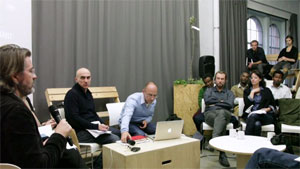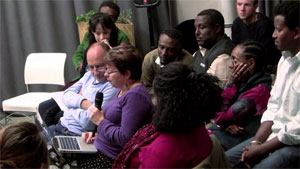22. November 2013 / Acting Archives, Marathon ⟶
Archives Works Marathon, Tag 3
Beiträge von
Beatrice von Bismarck, AA Bronson, Olafur Eliasson, Tue Greenfort, Koyo Kouoh, Armin Linke, Georges Pfruender, Nicola Setari, Louwrien Wijers
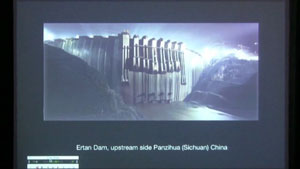
Armin Linke
Armin Linke presents his work, which focuses on questions of how to employ and think with images, especially from an archival perspective. He also discusses the relation between the Internet and architectural space, looking at the anthropological use of architecture.
Synthesis
Different ways to think and work with images • HfG Karlsruhe / ZKM • Project collaboration with Doreen Mende and Wilfried Kühn • Architettura • Collaboration with Alex Rich and Peter Hanappe • Ausklappen...
Different ways to think and work with images • HfG Karlsruhe / ZKM • Project collaboration with Doreen Mende and Wilfred Kühn • Architettura • Collaboration with Alex Rich and Peter Hanappe • Sony CSL Lab • Insurance companies do not insure artwork that can be touched • Oscar Niemeyer • Early project: an online image archive – shown at the Utopia Station, Venice Biennale • To bring the structure of the internet into the architectural space • Carlo Mollino • Anthropological use of architecture • The changing landscape of rural Italy through architecture • Bruno Latour • An Inquiry Into Modes of Existence • Phenotypes/Limited Forms • Performative installation • Using an algorithm to select the images • MMK – Museum für Moderne Kunst, Frankfurt a.M. • Making History • Corrado Calvo
Short biography
Armin Linke, artist working with film and photography, with an ongoing archive on human activity and natural and manmade landscapes. Ausklappen...
Armin Linke, artist working with film and photography, with an ongoing archive on human activity and natural and manmade landscapes. He is a professor at the HfG (Hochschule für Gestaltung) Karlsruhe, a guest professor in Arts and Design at the IUAV University in Venice, and a research affiliate at MIT Visual Arts Program Cambridge. He co-curated the project Double Bound Economies (2013), and together with Territorial Agency and Anselm Franke, he conceptualised and executed the Anthropocene Observatory video series at Haus der Kulturen der Welt, Berlin. Linke is also a part of Travelling Communiqué: Reading a Photo Archive (1948-1980).
Armin Linke präsentiert seine Arbeit mit einem Schwerpunkt auf Fragen wie man mit Bildern denken und arbeiten kann, besonders aus einer archivischen Perspektive. Er diskutiert außerdem auch die Beziehung zwischen Internet und architektonischem Raum und betrachtet hierbei die anthropologische Verwendung von Architektur.
Synthese
Unterschiedliche Arten mit Bildern zu denken und zu arbeiten • HfG Karlsruhe / ZKM • Projektzusammenarbeit mit Doreen Mende und Wilfried Kühn • Architettura • Ausklappen...
Unterschiedliche Arten mit Bildern zu denken und zu arbeiten • HfG Karlsruhe / ZKM • Projektzusammenarbeit mit Doreen Mende und Wilfred Kühn • Architettura • Zusammenarbeit mit Alex Rich und Peter Hanappe • Sony CSL Lab • Versicherungen versichern keine Kunstwerke die berührt werden dürfen • Oscar Niemeyer • Frühes Projekt: Ein Online Bildarchiv – gezeigt in der Utopia Station, Venice Biennale • Die Struktur des Internets in den architektonischen Raum bringen • Carlo Mollino • Anthropologische Verwendung von Architektur • Die sich durch Architektur verändernde Gestalt des ländlichen Italiens • Bruno Latour • An Inquiry Into Modes of Existence • Phenotypes/Limited Forms • Performative Installation • Verwendung eines Algorithmus zur Auswahl von Bildern • Museum für Moderne Kunst, Frankfurt a.M. • Making History • Corrado Calvo
Kurzbiografie
Armin Linke, Künstler. Er ist Professor an der HfG (Hochschule für Gestaltung) Karlsruhe, Ausklappen...
Armin Linke, Künstler. Er ist Professor an der HfG (Hochschule für Gestaltung) Karlsruhe, Gastprofessor für Kunst und Design an der IUAV Universität in Venedig und am MIT Visual Arts Program in Cambridge, USA. Er co-kuratierte das Projekt Double Bound Economies (2013) und konzeptualisierte und realisierte zusammen mit Territorial Agency und Anselm Franke die Anthropocene Observatory Videoreihe am Haus der Kulturen der Welt in Berlin. Linke ist außerdem Teil von Travelling Communiqué: Reading a Photo Archive (1948-1980).
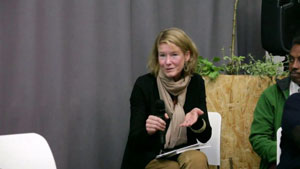
Beatrice von Bismarck
Beatrice von Bismarck speaks of the creation of the MA programme Cultures of the Curatorial and the involvement of the course participants in the curatorial project The Subjective Object. The project dealt with an archive of anthropological photography from the late 1920s of the Adivasi people of India and the political and socio-historical issues related to this archive. Several key questions are raised regarding colonialism, the anthropological gaze, the role of museums, the status of exhibits, the role of photography in relation to communal memory, and the ontological standing of the photograph itself.
Synthesis
Producing art and archives out of existing archives · The Subjective Object · The culture of a curatorial course · A project under the conditions of institutional limitations or perspectives · Ausklappen...
Producing art and archives out of existing archives · The Subjective Object · The culture of a curatorial course · A project under the conditions of institutional limitations or perspectives · How do things work within state institutions and how do we want to make them work in a different way? · Problematising the German photographic archive on the Adivasi of India in the Leipzig Museum of Ethnography · How can something so reproducible and unoriginal and not object-like be repatriated? · To bring that encounter in documented form back to Germany · The images helped create the Adivasi Academy in India · What has the photograph turned to? · What kind of item are we looking at? · Is this a document? · Is this in fact an object of the ancestors? · Is this a representation that equals the status of the ancestors? · The museum itself as an invention of the West now transplanted to India · The constantly shifting status of the image · How do you feed them back into a process of reading and rereading and even reconstructing a history through a constant rereading? · What can images actually do? · What do objects do? · How does meaning attach itself to images that gets shed away again through different contextualisation? · How can images become agents?
Short biography
Beatrice von Bismarck, professor of art history and visual culture at the Academy of Visual Arts Leipzig, is the co-founder and co-director of the project space Ausklappen...
Beatrice von Bismarck, professor of art history and visual culture at the Academy of Visual Arts Leipzig, is the co-founder and co-director of the project space Kunstraum der Leuphana Universität Lüneburg and of the project space /D/O/C/K at the Academy of Visual Arts Leipzig. She initiated and co-directs the MA programme Cultures of the Curatorial. Her current research areas focus on modes of cultural production connecting theory and practice, curatorial practice, and the effects of neo-liberalism and globalisation on the cultural field. Her publications include the seminal book Interarchive: Archival Practices and Sites in the Contemporary Art Field (2002), which was edited with Hans-Peter Feldmann, Hans Ulrich Obrist, Diethelm Stoller, and Ulf Wuggenig.
Beatrice von Bismarck spricht über die Entwicklung des MA Studienganges Kulturen des Kuratorischen und die Beteiligung der Studierenden am kuratorischen Projekt “The Subjective Object”. Das Projekt beschäftigt sich mit einem anthropologischen Fotoarchiv aus den späten 1920er Jahren, das die indischen Adivasi zeigt. Politische und soziohistorische Fragestellungen in Zusammenhang mit diesem Archiv werden untersucht. Kernfragen werden in Hinblick auf Kolonialismus, den anthropologischen Blick, die Rolle des Museums, den Status von Ausstellungen, die Rolle von Fotografie in Bezug zu geteilter Erinnerung sowie die ontologische Position des Fotos selbst gestellt.
Synthese
Produktion von Kunst und Archiven aus bestehenden Archiven · The Subjective Object · Kulturen des Kuratorischen Studiengang · Projekte unter den Bedingungen institutioneller Einschränkung oder Perspektiven · Ausklappen...
Produktion von Kunst und Archiven aus bestehenden Archiven· The Subjective Object · Die Kultur eines kuratorischen Studienganges · Projekte unter den Bedingungen institutioneller Einschränkung oder Perspektiven · Wie funktionieren Dinge in staatlichen Institutionen und wie wollen wir sie auf andere Weise funktionieren lassen? · Problematisierung des deutschen Fotoarchives über die indischen Adivasi im Leipziger Museum für Ethnografie · Wie kann etwas so reproduzierbares und nicht-objekthaftes an seinen Ursprung zurückgeführt werden? · Dieses Treffen in dokumentierter Form nach Deutschland zurückbringen · Die Bilder trugen dazu bei, die Adivasi Academy in Indien zu gründen · Wohin hat sich das fotografische Bild gewendet? · Was für ein Ding sehen wir? · Ist dies ein Dokument? · Ist das hier vielleicht sogar ein Objekt der Vorfahren? · Ist dies eine Darstellung, die die Stellung der Vorfahren wertgleich repräsentiert? · Das Museum als westliche Erfindung, nach Indien übertragen · Die sich andauern verändernde Stellung des Bildes · Wie lassen sie sich wieder zurückführen in einen Prozess des Lesens, Wiederlesens und sogar der Rekonstruktion von Geschichte durch beständiges Wiederlesen? · Was können Bilder tatsächlich bewirken? · Was tun Objekte? · Wie erhalten Bilder Bedeutung, die dann durch unterschiedliche Kontexte wieder verschwindet? · Wie können Bilder aktiv handeln?
Kurzbiografie
Beatrice von Bismarck, Professorin für Kunstgeschichte an der Hochschule für Grafik und Buchkunst Leipzig ist Mitbegründerin und Co-Direktorin des Projektraumes Kunstraum Ausklappen...
Beatrice von Bismarck, Professorin für Kunstgeschichte an der Hochschule für Grafik und Buchkunst Leipzig ist Mitbegründerin und Co-Direktorin des Projektraumes Kunstraum an der Leuphana Universität in Lüneburg sowie des Projektraumes D/O/C/K an der Hochschule für Grafik und Buchkunst in Leipzig. Sie begründete den MA Studiengang Kulturen des Kuratorischen und leitet diesen als Ko-Direktorin. Ihre aktuelle Forschung konzentriert sich auf Modi der Kulturproduktion und verbindet Theorie mit Praxis, kuratorischer Praxis sowie den Einflüssen des Neoliberalismus und der Globalisierung auf den Kulturbereich. Zu ihren Publikationen zählt u.a. das Buch Interarchive: Archival Practices and Sites in the Contemporary Art Field (2002), das zusammen mit Hans-Peter Feldmann, Hans Ulrich Obrist, Diethelm Stoller und Ulf Wuggenig herausgegeben wurde.
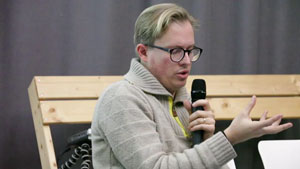
Nicola Setari
Nicola Setari discusses the issues surrounding the work he did for Visionary Africa and his collaboration with architect David Adjaye on GEO-Graphics. The presentation focuses on the itinerancy of Visionary Africa in different African capitals and on the many questions surrounding the representation of African culture within contemporary European institutions. Setari discusses the controversial notion of cultural restitution between European and African countries as well as the politics of working with existing ethnographic collections in Europe.
Synthesis
Visionary Africa · Bruno Latour · Iconoclash: Beyond the Image Wars in Science, Religion, and Art · The whole question of iconoclasm in contemporary culture has been a theme of reflection and investigation · Ausklappen...
Visionary Africa · Bruno Latour · Iconoclash: Beyond the Image Wars in Science, Religion, and Art · The whole question of iconoclasm in contemporary culture has been a theme of reflection and investigation · Brussels: BOZAR Centre for Fine Arts and the Tervuren Museum · An opportunity to reflect on the problem of relations between European museums, ethnographic museums, and the African continent · On one side there was the theme of heritage and on the other side there was the question of visual stereotypes · British-Ghanaian architect, David Adjaye · Book: African Metropolitan Architecture – fifty-four capitals are reorganised according to climate zones on the continent, therefore liberating them of their national identity · The Atlas Research Project: a timeline mapping a hundred years of the evolution of policies on the management of culture on the African continent · GEO-Graphics: part of the bigger project Visionary Africa · Two main exhibitions: GEO-Graphics and A Useful Dream · Using colour codes and labels to decontextualise national identity
Short biography
Nicola Setari, researcher, curator, editor, and professor of visual anthropology at the Milan New Fine Arts and Design Academy. Ausklappen...
Nicola Setari, researcher, curator, editor, and professor of visual anthropology at the Milan New Fine Arts and Design Academy. He was an agent of dOCUMENTA (13) in Kassel, Germany, contributing to the artistic and educational programme. He also co-edited part of the dOCUMENTA (13) catalogue – The Logbook (2012). Between 2006 and 2009, he was editor-in-chief and publisher of the cross-disciplinary art magazine Janus. In 2010 and 2011, he was co-curator of the Visionary Africa platform for the Centre for Fine Arts in Brussels and co-editor of David Adjaye’s GEO-Graphics: A Map of Art Practices in Africa, Past and Present (2010).
Nicola Setari thematisiert und diskutiert Visionary Africa und seine Zusammenarbeit mit dem Architekten David Adjaye für GEO-Graphics. Die Präsentation konzentriert sich auf die Reisen von Visionary Africa in verschiedene afrikanische Hauptstädte und auf die vielen Fragen rund um Repräsentationen afrikanischer Kultur durch zeitgenössische europäische Institutionen. Setari diskutiert kontroverse Zusammenhänge der kulturellen Entschädigung zwischen europäischen und afrikanischen Ländern sowie den Umgang mit ethnografischen Sammlungen in Europa.
Synthese
Visionary Africa · Bruno Latour · Iconoclash: Beyond the Image Wars in Science, Religion, and Art · Die Frage des Ikonoklasmus in der zeitgenössischen Kultur war eine Frage des Nachdenkens und Nachforschens · Ausklappen...
Visionary Africa · Bruno Latour · Iconoclash: Beyond the Image Wars in Science, Religion, and Art · Die Frage des Ikonoklasmus in der zeitgenössischen Kultur war eine Frage des Nachdenkens und Nachforschens · Brüssel: BOZAR Centre for Fine Arts und das Tervuren Museum · Eine Gelegenheit über Probleme in den Beziehungen zwischen europäischen Museen, ethnografischen Museen und dem afrikanischen Kontinent nachzudenken · Einerseits Thema Kulturerbe und andererseits die Frage nach visuellen Stereotypen · British-Ghanaischer Architekt, David Adjaye · Buch: African Metropolitan Architecture – 54 Hauptstädte werden entsprechend den Klimazonen des Kontinentes neu geordnet und so von ihrer nationalen Identität befreit · The Atlas Research Project: Ein Zeitstrahl der Überblick gibt über die hundertjährige Evolution von Kulturmanagementpolitik auf dem afrikanischen Kontinent · GEO-Graphics: Teil des größeren Projektes Visionary Africa · Zwei große Ausstellungen: GEO-Graphics und A Useful Dream · Verwendung von Farbcodes und Etiketten zur Dekonstruktion nationaler Identität
Kurzbiografie
Nicola Setari, Kurator, Redakteur und Professor für visuelle Anthropologie an der New Fine Arts and Design Academy in Mailand. Ausklappen...
Nicola Setari, Kurator, Redakteur und Professor für visuelle Anthropologie an der New Fine Arts and Design Academy in Mailand. Er war ein Agent der dOCUMENTA (13) in Kassel und trug zum künstlerischen Programm und zum Bildungsprogramm bei und zum Documenta-Katalog The Logbook (2012) bei. Zwischen den Jahren 2006 und 2009 war er Chefredakteur des interdisziplinären Kunstmagazins Janus. In den Jahren 2010 und 2011 war er Co-Kurator der Platform Visionary Africa am Centre for Fine Arts in Brüssel und Mitherausgeber von David Adjayes GEO-Graphics: A Map of Art Practices in Africa, Past and Present (2010).
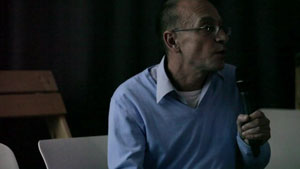
Georges Pfruender
Georges Pfruender explores several issues concerning archives today and their role within society in general, especially in relation to issues such as ethics, colonisation, apartheid in South Africa, the decolonisation of the self, ‘white nostalgia’, and methodological pluralism.
Synthesis
Art institutions as separate entities from universities • The apartheid archives • Revisiting the idea of the archive • Archives command and have their own authority • Ausklappen...
School of Arts at the University of the Witwatersrand • Art institutions as separate entities from universities • The apartheid archives • Revisiting the idea of the archive • Archives command and have their own authority • The archives in South Africa must be visited from that point of view • Who are the archivists? Under what conditions is the archiving processes happening? • How are these archives made available to the public? • Artist William Kentridge • Hesitation around archives • Jacques Derrida - instead of being something solid, the archive should be something that holds us, something unsolved, something that needs to be addressed • Ethics are a core part in whatever we think about archives • An archive not re-performed is not a real archive • ‘White nostalgia’ - an interesting way to think around apartheid archives • Archives have agency and are not innocent things • Decolonisation is not necessarily an act that happens on a territory • How do we decolonise ourselves? • Collective memories and alternative subject positions • Methodological pluralism • Researchers should also be transformed by this process • Jeppe Street – Johannesburg • Difficult to be a migrant in an unstable setting • The sharing of stories, the exchanges of stories
Short biography
Georges Pfruender, head of the Wits School of Arts at the University of the Witwatersrand, Johannesburg, from 2009 to 2013. Ausklappen...
Georges Pfruender, head of the Wits School of Arts at the University of the Witwatersrand, Johannesburg, from 2009 to 2013. From 1996 to 2009, he directed the Institute of Fine Arts, Ecole Cantonale d’Art du Valais (ECAV) in Switzerland, and he was president of the Swiss National Board of Art and Design from 2004 and 2008. As an artist and researcher, he has participated in conferences, panels, and residency programmes in Europe, North and South America, Africa, and Asia, and is presently coordinating collective art projects in collaboration with Cynthia Kros that involve researchers from South Africa, Ethiopia, and France.
Georges Pfruender untersucht verschiedene Aspekte heutiger Archive und deren Rolle innerhalb der Gesellschaft. Insbesondere betrachtet er dabei die Beziehung zu Themengebieten wie Ethik, Kolonialisierung, Apartheid in Südafrika, Dekolonialisierung des Selbst, „weiße Nostalgie“ und methodologischer Pluralismus.
Synthese
Kunstinstitutionen als von Universitäten unabhängige Einheiten • Neubetrachtung des Apartheid-Archivs • Archive haben ihre eigene Autorität • Ausklappen...
Kunstinstitutionen als von Universitäten unabhängige Einheiten • Neubetrachtung des Apartheid-Archivs • Archive haben ihre eigene Autorität • Archive in Südafrika müssen von dieser Perspektive aus betrachtet werden • Wer sind die Archivare? Unter welchen Bedingungen laufen Archivierungsprozesse ab? • Wie werden Archive der Öffentlichkeit zugänglich gemacht? • Künstler William Kentridge • Zögern beim Thema Archive • Jacques Derrida – statt statisch zu sein, sollte das Archiv etwas sein das uns trägt, etwas ungelöstes, etwas das thematisiert werden muss • Ethik steht im Zentrum des Nachdenkens über Archive • Ein Archiv das nicht aktiviert wird ist kein echtes Archiv • ‘Weiße Nostalgie’ – eine interessante Betrachtungsweise des Apartheid-Archivs • Archive haben Handlungsmacht und sind keine unschuldigen Dinge • Dekolonialisierung ist nicht etwas das nur auf einem bestimmten Gebiet passiert • Wie dekolonisieren wir uns selbst? • Kollektive Erinnerungen und alternative Subjektpositionen • Methodologischer Pluralismus • Forscher sollen von diesem Prozess verändert werden • Jeppe Street – Johannesburg • Schwierig, Migrant in einer instabilen Situation zu sein • Teilen und Austausch von Geschichten
Kurzbiografie
Georges Pfruender, Leiter der Wits School of Arts an der University of the Witwatersrand, in Johannesburg von 2009 bis 2013. Ausklappen...
Georges Pfruender, Leiter der Wits School of Arts an der University of the Witwatersrand, in Johannesburg von 2009 bis 2013. Zwischen 1996 und 2009 leitete er das Institut für bildende Kunst an der Ecole Cantonale d’Art du Valais (ECAV) in der Schweiz und war von 2004 bis 2008 Vorsitzender des Schweizer Rat für Kunst und Design. Als Künstler und Wissenschaftler nahm er an Konferenzen, Talks und Residencyprogrammen in Europa, Nord- und Südamerika, Afrika und Asien teil. Aktuell koordiniert er ein kollektives Kunstprojekt in Zusammenarbeit mit Cynthia Kros mit Forschern und Wissenschaftlern aus Südamerika, Äthiopien und Frankreich.
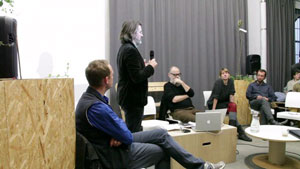
Olafur Eliasson
Olafur Eliasson presents his website as a living archive, exploring the definition of an archive and an archive’s nature as proactive or retroactive. His discussion is supplemented with examples from his own career and his online archive.
Synthesis
The start of an archive • The transition from one type of medium to another • A website as an archive • Sticky Rice – intuitive system • The internet as a gathering of material • Ausklappen...
The start of an archive • The transition from one type of medium to another • A website as an archive • Sticky Rice – intuitive system • The internet as a gathering of material • A retroactive or proactive archive • More access to the work online than at exhibitions • Changing perspective of own work • How to represent online the process of producing work? • Examples of how his website functions • How to generate a system for viewing and cataloguing the work online? • Archive or catalogue? • Does an artist’s archive include the artwork? • Archival thinking as future co-production
Short biography
Olafur Eliasson, Danish-Icelandic artist, founded the Institut für Raumexperimente, an educational research project, affiliated with the College of Fine Arts at the Berlin University of the Arts (UdK) Ausklappen...
Olafur Eliasson, Danish-Icelandic artist, founded the Institut für Raumexperimente, an educational research project, affiliated with the College of Fine Arts at the Berlin University of the Arts (UdK). The fundamental trajectory of the Institut für Raumexperimente is Eliasson’s interest in testing models of learning and cultivating experimental formats.
Olafur Eliasson präsentiert seine Website als lebendiges Archiv und diskutiert dabei die Definition des Archivs selbst sowie die Natur des Archivs als proaktiv beziehungsweise retroaktiv. Seine Überlegungen wurden durch Beispiele aus seiner eigenen Künstlerkarriere unterlegt.
Synthese
Der Beginn eines Archivs • Der Übergang von einer Art Medium zu einer anderen • Website als Archiv • Sticky Rice – intuitives System • Das Internet als Materialsammlung • Ausklappen...
Der Beginn eines Archivs • Der Übergang von einer Art Medium zu einer anderen • Website als Archiv • Sticky Rice – intuitives System • Das Internet als Materialsammlung • Ein retroaktives oder proaktives Archiv • Online mehr Zugang zu Arbeiten als in der Ausstellung • Sich wandelnde Perspektiven auf das eigene Werk • Wie kann der Produktionsprozess eines Kunstwerkes online repräsentiert werden? • Beispiele wie seine Website funktioniert • Wie schafft man ein System zum Betrachten und Katalogisieren von Arbeiten online? • Archiv oder Katalog? • Enthält ein Künstlerarchiv die Kunstwerke? • Archivisches Denken als zukünftige Koproduktion
Kurzbiografie
Olafur Eliasson, dänisch-isländischer Künstler, gründete das Institut für Raumexperimente, ein Studien- und Forschungsprojekt, Ausklappen...
Olafur Eliasson, dänisch-isländischer Künstler, gründete das Institut für Raumexperimente, ein Studien- und Forschungsprojekt, das Teil der Fakultät für Bildende Kunst an der Universität der Künste Berlin (UdK) ist. Eliassons Interesse, neue Lernmodelle zu testen und experimentelle Formate zu kultivieren, ist grundlegender Bestandteil des Institutsprogramms.
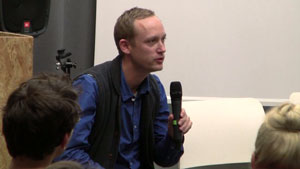
Tue Greenfort
Tue Greenfort presents on his recent projects, especially his work with water and an international water archive, as well as how this helps to understand changing landscapes and open dialogues on subjects such as biozone protection and the relation between computer science and thought.
Synthesis
dOCUMENTA (13) • Multi-species archive – human and non-human animals • Water archive • Water pollution and drinkability • Ausklappen...
Danish artist living in Berlin • dOCUMENTA (13) • Multi-species archive – human and non-human animals • Water archive • Water pollution and drinkability • Place specific – samples from around the world • Symbolic value of objects • Closed ecosystem • What is the difference between an archive and a collection? • A collection that opens dialogue • Water as a political issue • Different approaches to water • Exhibition at SculptureCenter in New York • Hurricane Sandy • Reaction to the hurricane • The changing landscape of New York • How to re-think the environment in an urban area • The horseshoe crab • Evolutionary time scale • Dialogue on biozone protection • New York context • The relation between computer science and ecological thought
Short biography
Tue Greenfort, artist. As a participant in dOCUMENTA (13) in Kassel, Germany, Greenfort was co-curator of an archive on multi-species co-evolution, The Worldly House. Ausklappen...
Tue Greenfort, artist. As a participant in dOCUMENTA (13) in Kassel, Germany, Greenfort was co-curator of an archive on multi-species co-evolution, The Worldly House. Solo presentations include Berlinische Galerie (2012), South London Gallery (2011), Kunstverein Braunschweig (2008), and Secession, Vienna (2007). Among his publications, the most comprehensive, Linear Deflection, was published by Walther König in 2009.
Tue Greenfort spricht über seine aktuellen Projekte, besonders seine Arbeit mit Wasser und seine Initiative für ein internationales Wasserarchiv. Außerdem thematisiert er, wie dies uns hilft, sich verändernde Landschaften zu verstehen und Diskurse zu Themen wie Biozonenschutz oder zu der Beziehung zwischen Computerwissenschaften und Theorie zu öffnen.
Synthese
dOCUMENTA (13) • Multispezies Archiv - menschliche und nichtmenschliche Tiere • Wasserarchiv • Wasserverschmutzung und Trinkbarkeit • Ausklappen...
Dänischer Künstler der in Berlin wohnt • dOCUMENTA (13) • Multispezies Archiv - menschliche und nichtmenschliche Tiere • Wasserarchiv • Wasserverschmutzung und Trinkbarkeit • Ortsspezifisch – Proben von überall auf der Welt • Symbolischer Wert von Objekten • Geschlossene Ökosysteme • Was ist der Unterschied zwischen einem Archiv und einer Sammlung? • Eine Sammlung, die Dialoge eröffnet • Wasser als Politikum • Unterschiedliche Ansätze zum Thema Wasser • Ausstellung im SculptureCenter in New York • Hurrikan Sandy • Reaktionen auf den Hurrikan • Die sich verändernde Landschaft New Yorks • Wie denkt man die Umgebung in einer urbanen Gegend neu? • Der Pfeilschwanzkrebs • Evolutionärer Zeitrahmen • Dialog über Biozonenschutz • New York als Kontext • Die Beziehung zwischen Computerwissenschaft und ökologischen Gedanken
Kurzbiografie
Tue Greenfort, Künstler. Als ein Teilnehmer der dOCUMENTA (13) in Kassel war Greenfort Ko-Kurator eines Archivs für spezienübergreifende Ko-Evolution, The Worldly House. Ausklappen...
Tue Greenfort, Künstler. Als ein Teilnehmer der dOCUMENTA (13) in Kassel war Greenfort Ko-Kurator eines Archivs für spezienübergreifende Ko-Evolution, The Worldly House. Soloschauen seiner Werke umfassen die Berlinische Galerie (2012), die South London Gallery (2011), den Kunstverein Braunschweig (2008), und Secession, Wien (2007). Die umfangreichste seiner Publikationen, Linear Deflection, wurde von Walther König im Jahr 2009 herausgegeben.
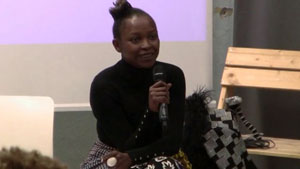
Koyo Kouoh
Koyo Kouoh presents the living archive of artist Issa Samb and discusses the importance of the artist’s work in Senegal in relation to major historical events, as well as the importance of preserving such an archive for the memory of Senegal.
Synthesis
An example of a living archive • The archive of artist Issa Samb from Dakar • Became political at the age of 13 • Politically active in West Africa for over 50 years • Ausklappen...
An example of a living archive • The archive of artist Issa Samb from Dakar • Became political at the age of 13 • Politically active in West Africa for over 50 years • Disruption of Charles De Gaulle’s visit to West and Central Africa • Living and performing his own archive on a daily basis • First artist collective in Senegal during the 1970s, the Laboratoire Agit’Art • Djibril Diop Mambéty • dOCUMENTA
Short biography
Koyo Kouoh, the founder of RAW Material Company, a centre for art, knowledge, and society, makes exhibitions, publishes books and helps others in the same labour. Ausklappen...
Koyo Kouoh, the founder of RAW Material Company, a centre for art, knowledge, and society, makes exhibitions, publishes books and helps others in the same labour. Her discursive programmes, exhibitions and publications have included contemporary artists, thinkers, writers, activists, non-artists, designers, politicians, architects, and chefs.
Koyo Kouoh präsentiert das Archiv des Künstlers Issa Samb und diskutiert die Bedeutsamkeit seines Werks in Senegal in Bezug zu bedeutenden historischen Ereignissen sowie der Wichtigkeit, ein solches Archiv für die Erinnerungskultur in Senegal zu bewahren.
Synthese
Beispiel für ein lebendiges Archiv • Das Archiv des Künstlers Issa Samb aus Dakar • Wurde im Alter von 13 Jahren politisch interessiert • Ausklappen...
Beispiel für ein lebendiges Archiv • Das Archiv des Künstlers Issa Samb aus Dakar • Wurde im Alter von 13 Jahren politisch interessiert • Seit über 50 Jahren in Westafrika politisch aktiv • Störung von Charles De Gaulles Besuch in West- und Zentralafrika • Lebt und performt sein eigenes Archiv als tägliche Praxis • Erstes Künstlerkollektiv in Senegal während der 1970er Jahre, das Laboratoire Agit’Art • Djibril Diop Mambéty • dOCUMENTA
Kurzbiografie
Koyo Kouoh, Gründungsdirektorin von RAW Material Company, einem Zentrum für Kunst, Wissen und Gesellschaft. Sie kuratiert Ausstellungen, veröffentlicht Bücher und hilft anderen im gleichen Berufszweig. Ausklappen...
Koyo Kouoh, die Gründerin der RAW Material Company, einem Zentrum für Kunst, Wissen und Gesellschaft schafft Ausstellungen, veröffentlicht Bücher und hilft anderen im gleichen Berufszweig. Ihre diskursiven Programme, Ausstellungen und Publikationen bringen zeitgenössische Künstler, Denker, Autoren, Aktivisten, Nichtkünstler, Designer, Politiker, Architekten und Köche zusammen.
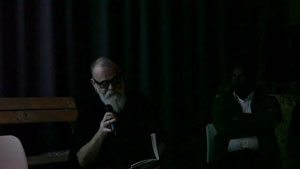
AA Bronson
AA Bronson presents five decades of his work as an artist. He explores issues of artists working collectively, artists’ books, networking, archival practices and cultures, AIDS, and personal projects. He speaks of projects such as Printed Matter, General Idea, File Megazine, Art Metropole, Other Books, Ecart, and The 1984 Miss General Idea Pavilion.
Synthesis
Printed Matter • Artists’ books from around the world in the 60s and 70s • Artists networking via self-made books • General Idea • Working as a collective and receiving and producing print material • Ausklappen...
Printed Matter • Artists’ books from around the world in the 60s and 70s • Artists networking via self-made books • General Idea • Working as a collective and receiving and producing print material • File Megazine • One of the earliest artist-run magazines • Acting as a network of artists • Existing outside the mainstream distribution channels • Art Metropole • System for artists’ projects in multiple formats • Other Books • Ecart • Nodes of a distribution system • Sol Lewitt • Franklin Furnace • Split between Printed Matter and Franklin Furnace: one became a bookshop and the other an archive • AIDS in the 80s and 90s forced artists’ archives to be formed during middle age • The difference between an archive and a library • Miss General Idea Pavilion • Self-generated, parallel art system • Generating an archive through mailing projects with other artists • Non-hierarchical approach to received material • Plain paper copier starts punk-zine boom • Manipulating the Self – book exploring the concept of self- and audience manipulation • Wittgenstein
AA Bronson stellt fünf Jahrzehnte seiner künsterischen Arbeit vor. Er geht dabei auf kollektive künstlerische Arbeit, Künstlerbücher, Networking, Archivpraktiken und Kulturen, AIDS und persönliche Projekte ein. Erwähnt warden unter anderem Projekte wie Printed Matter, General Idea, File Megazine, Art Metropole, Other Books, Ecart, und The 1984 Miss General Idea Pavilion.
Synthese
Printed Matter • Internationale Künstlerbücher in den 1960er und 1970er Jahren • Künstlernetzwerke durch selbst produzierte Bücher • General Idea • Arbeit im Kollektiv und Annahme sowie Produzieren von Printmaterial • Ausklappen...
Printed Matter • Internationale Künstlerbücher in den 1960er und 1970er Jahren • Künstlernetzwerke durch selbst produzierte Bücher • General Idea • Arbeit im Kollektiv und Annahme sowie Produzieren von Printmaterial • File Megazine • Eines der ersten künstlergeführten Magazine • Handeln als Künstlernetzwerk • Bestehen außerhalb der populären Distributionswege • Art Metropole • Systeme für Künstlerprojekte in verschiedenen Formaten • Other Books • Ecart • Knotenpunkte eines Vertriebssystems • Sol Lewitt • Franklin Furnace • Teilung in Printed Matter und Franklin Furnace, wovon eines ein Buchladen, das andere ein Archiv wurde • AIDS in den 1980er und 1990er Jahren machte es notwendig, dass Künstlerarchive im mittleren Alter begonnen wurden • Der Unterschied zwischen einem Archiv und einer Bibliothek • Miss General Idea Pavilion • Selbstgeschaffenes, paralleles Kunstsystem • Schaffung eines Archives durch postalischen Austausch über Projekte mit anderen Künstlern • Nicht-hierarchischer Umgang mit erhaltenem Material • Die Kopiermaschine begründet den Boom der Punk-Zines • Manipulating the Self – Buch, das das Konzept von Selbst und Publikumsmanipulation erforscht • Wittgenstein
Kurzbiografie
AA Bronson, Künstler, begründete im Jahr 1969 die Künstlergruppe General Idea mit Felix Partz und Jorge Zontal. Er ist außerdem als Gründer von Art Metropole (1974), Ausklappen...
AA Bronson, Künstler, begründete im Jahr 1969 die Künstlergruppe General Idea mit Felix Partz und Jorge Zontal. Er ist außerdem als Gründer von Art Metropole (1974), der NY Art Book Fair (2006) sowie dem Institute for Art, Religion and Social Justice (2008) bekannt. Er war von 2004 bis 2010 Leiter von Printed Matter, Inc und lehrte an der UCLA, der University of Toronto und der Yale School of Art. AA Bronsons eigenes Werk beschäftigt sich mit Trauma, Verlust, Tod und Heilung aus der Perspektive der Queer Theory. Sein Oeurvre – als Künstler, Heiler, Kurator und Lehrender – ist geprägt von kollaborativer Praxis und Konsensfindung. Er hatte zahlreiche internationale Einzelausstellungen und erhielte ebenso zahlreiche Auszeichnungen und Ehrendoktortitel.
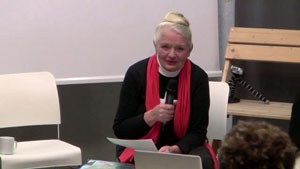
Louwrien Wijers
Louwrien Wijers speaks about her project for Museum Night in Amsterdam called Writing a Sculpture Void, which challenges preconceived notions of the relation between art, science, and spirituality. By talking about the work of several artists, scientists, spiritual leaders, she problematises our contemporary, mechanistic worldview and proposes that art practice is a possible way to discover new paradigms.
Synthesis
Museum Night in Amsterdam · George Brecht’s book: Void · Lots of wonderful coloured lines · Art Meets Science and Spirituality in a Changing Economy · Project: Writing a Sculpture Void · Ausklappen...
Museum Night in Amsterdam · George Brecht’s book: Void · Lots of wonderful coloured lines · Art Meets Science and Spirituality in a Changing Economy · Project: Writing a Sculpture Void · The way change takes place in art is very similar to the way change takes place in science · Revolutionary art signals a shift in paradigm · Giving up the idea of only a few people leading a pack of other people who are following · The art situation as a whole forms a network or a spiral · Works of art are always direct · Fritjof Capra’s The Tao of Physics · We no longer assume there is any real world with which we have to establish contact · The Heart Sutra: form is emptiness, emptiness is form · Enlightenment: a state beyond the uncontrolled, agitated, dissatisfied mind · Contemporary science teaches us that it is not a matter of fixed facts anymore but of dynamic systems, not of eternal truths but of dialogue · An artist can express human feelings · Art can come from inside or outside, but inside and outside are not different
Short biography
Louwrien Wijers, a writer and visual artist whose practice revolves specifically around sculpture, both mental and material. Ausklappen...
Louwrien Wijers, a writer and visual artist whose practice revolves specifically around sculpture, both mental and material. From 1968 to 1986, Wijers worked closely with Joseph Beuys to train herself to look at, write, and speak ‘like’ a sculpture. Wijers’ most important mental sculpture to date, titled Art Meets Science and Spirituality in a Changing Economy (1990/1996) is a direct result of a meeting of Joseph Beuys and the Dalai Lama she organised in Bonn in 1982. The influence of food on our future is now her main topic.
Louwrien Wijers spricht über ihr Projekt Writing a Sculpture Void für die Nacht der Museen in Amsterdam. Hierin stellt sie vorgefertigte Verständisse der Beziehung zwischen Kunst, Wissenschaft und Spiritualität in Frage. Durch eine Diskussion der Arbeit verschiedener Künstler, Wissenschaftler und religiöser Führer problematisiert sie unsere zeitgenössische mechanistische Weltsicht und stellt die These auf, dass künstlerische Praxis ein möglicher Weg ist, auf dem neue Paradigmen entdeckt werden können.
Synthese
Nacht der Museen in Amsterdam · George Brechts Buch: Void · Viele wunderbare bunte Linien · Art Meets Science and Spirituality in a Changing Economy · Projekt: Writing a Sculpture Void · Ausklappen...
Nacht der Museen in Amsterdam · George Brechts Buch: Void · Viele wunderbare bunte Linien · Art Meets Science and Spirituality in a Changing Economy · Projekt: Writing a Sculpture Void · Die Art, auf die Veränderung in der Kunst stattfindet, ist der Art auf die Veränderung in der Wissenschaft stattfindet sehr ähnlich · Revolutionäre Kunst signalisiert einen Paradigmenwechsel · Abschied von der Idee dass wenige eine Menge anleiten, die bloß folgt · Die Situation in der Kunst hat die Form eines Netzwerks oder einer Spirale · Kunstwerke sind immer direkt · Fritjof Capras’ The Tao of Physics · Wie nehmen nicht länger an, dass es irgendeine reale Welt gibt mit der wir in Kontakt treten müssen · Das Herz Sutra: Form ist Leere, Leere ist Form · Erleuchtung: Ein Zustand jenseits des unkontrollierten, ängstlichen und unzufriedenen Geistes · Zeitgenössische Wissenschaft lehrt uns, dass es nicht mehr um festgelegte Fakten geht sondern um ein dynamisches System, nicht um ewige Wahrheiten sondern um Dialog · Ein Künstler kann menschlichen Gefühlen Ausdruck verleihen · Kunst kann von Innen oder von Außen kommen, aber Innen und Außen unterscheiden sich nicht
Kurzbiografie
Louwrien Wijers, Autorin und bildende Künstlerin, deren Arbeitsweisen sich im Bereich mentaler und materieller Bildhauerei abspielen. Ausklappen...
Louwrien Wijers, Autorin und bildende Künstlerin, deren Arbeitsweisen sich im Bereich mentaler und materieller Bildhauerei abspielen. Von 1968 bis 1986 arbeitete Wijers eng mit Joseph Beuys zusammen, um Skulptur zu betrachten und "wie eine Skulptur" zu schreiben und sprechen. Wijers wichtigste gedankliche Skulptur ist bis heute unter dem Titel Art Meets Science and Spirituality in a Changing Economy (1990/1996) bekannt und ein direktes Ergebnis des Treffens zwischen Joseph Beuys und dem Dalai Lama, das sie 1982 in Bonn organisierte. Ihr Hauptthema ist aktuell der Einfluss von Nahrungsmitteln auf unsere Zukunft.
